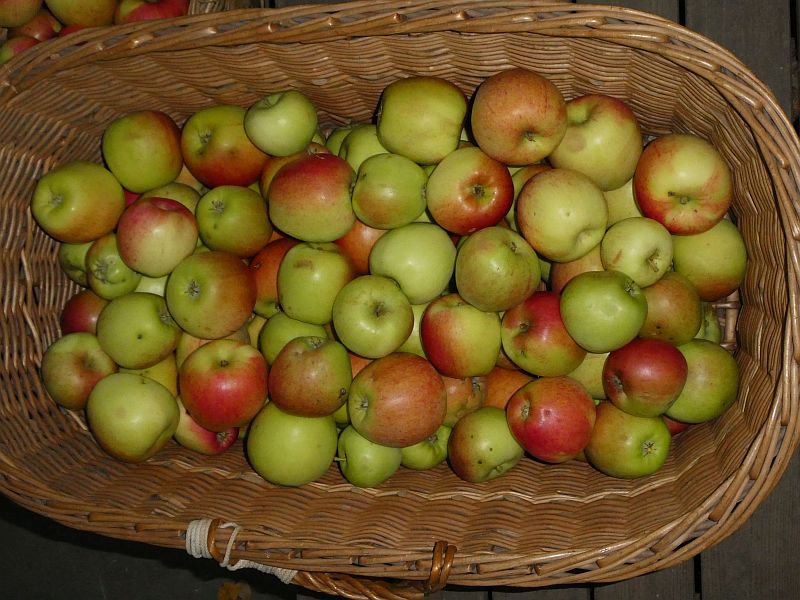A hooded crow (kråke) in the garden on one of the last apples still hanging in the tree with deep snow now covering fallen apples.
Tag Archives: Apple
Autumn berries and fruit
As far as possible, I like to eat fresh fruit and berries from the garden, usually with muesli for breakfast. I’ve been self-sufficient for many years, mostly home grown but augmented with wild foraged bilberries / blåbær. From when the cellar stored apples are finished, usually in April to the first haskaps and strawberries are ready, we go over to rehydrated dried fruit. Currently these are the berries and fruit we are eating now in autumn as the first frosts threaten:
1. Elaeagnus umbellata (autumn olive; Japansk sølvbusk)
2. Rubus ‘Sonja’ (blackberry; bjørnebær) – the only blackberry cultivar I am aware of that is hardy enough for our climate, not freezing in winter. Productive with tasty berries too!
3. Ribes divaricatum “Worcesterberry” (Worcesterbær)
4. Ribes biebersteinii (Ribes petraeum var. biebersteinii) (black redcurrant; svartrips); isn’t truly black, more dark purple coloured; hang a long time on the bushes and don’t seem to be taken by thrushes (like blackcurrants)
5. Malus domestica (apple; epler) – eating the windfalls that won’t store long.

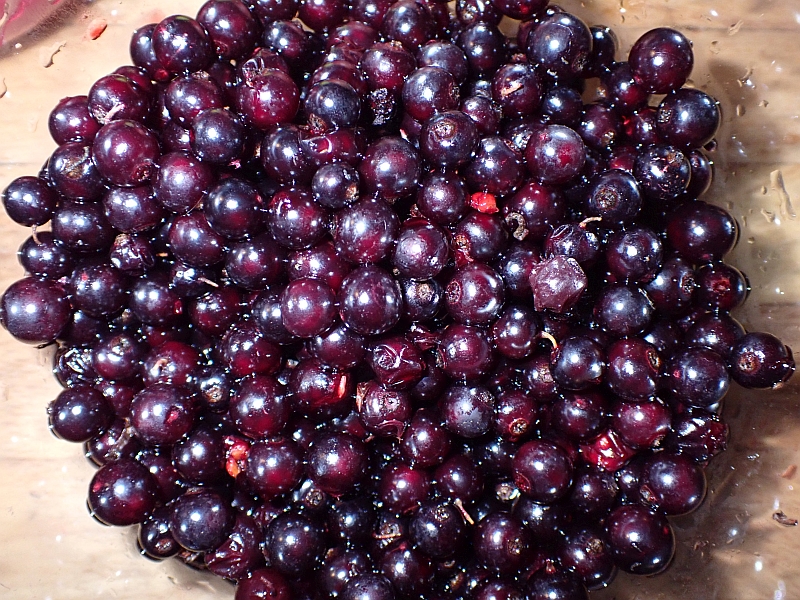
Slow barlotto
Tonight’s dinner was slow (kortreist) barlotto (byggotto) with whole grain Norwegian organic barley with:
Mashua (Tropaeolum tuberosum) “Ken Aslet” and “White”
Persian shallots (Allium stipitatum)
Wapato (Sagittaria latifolia)
Carrot / gulrot
Chicory / raddichio (2 varieties) (Cichorium intybus)
Swiss chard / mangold
Leek / purre
Bulb onion / kepaløk (2 varieties)
Tomatoes / tomat (a mix of the last of this year’s crop)
Madeira vine (Anredera cordifolia)
Bay leaf / laurbærblad
Apple / eple
Dandelion / løvetann
Garlic / hvitløk
Celery / selleri (3 varieties)
Matriske / saffron milkcap (rehydrated)
Chili and a local blue cheese “Hitra Blå”
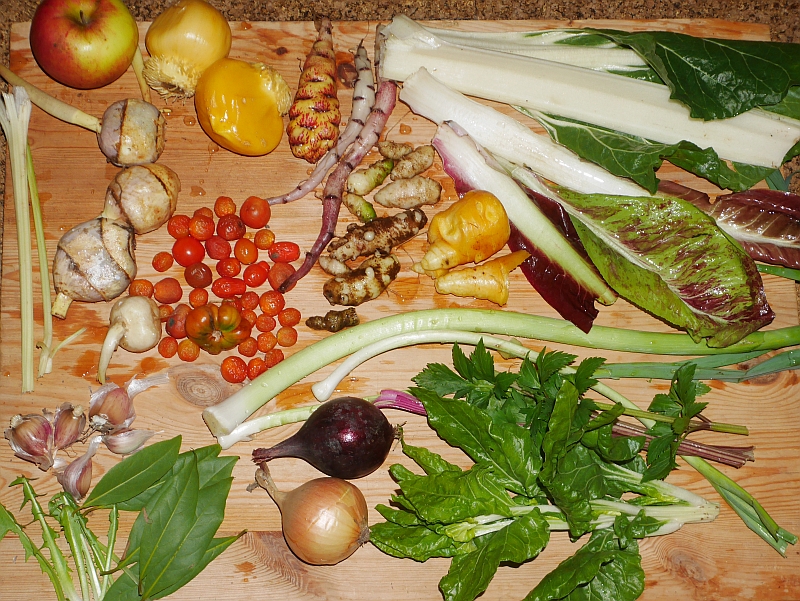
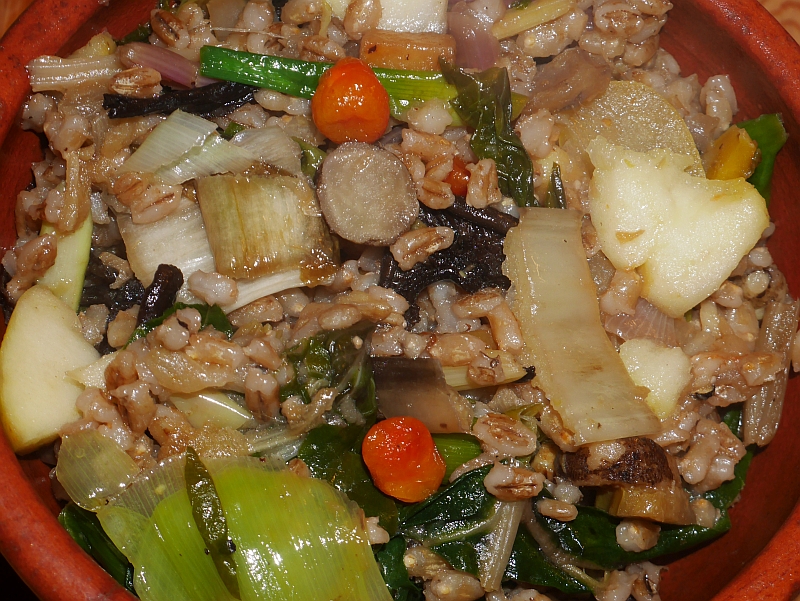
Waxwings on apples
Waxwings (sidensvans) have arrived here in numbers with about 70 in the garden today! Most of their favourite berry, rowan (rogn) had gone by the time they arrived due to the large flocks of thrushes that were here a week ago (mainly fieldfares, redwings and blackbirds / gråtrost, rødvingetrost og svarttrost). They had opened up quite a few apples near the tops of the trees before they moved on, and now the waxwings are enjoying them – they luckily don’t try to open other apples, so that there are still many for us! We’ve been harvesting the last few days, but still a lot near the tops of the trees that are difficult to reach even with the apple picker!
Waxwing and Tawny Owl
A small flock of Waxwings (sidensvans) finally arrived at the end of November and have been foraging in the garden since (rowans / rogn failed this year). In these videos, they are eating apples, elderberry and guelder rose berries (epler, svarthyll and krossved). I’ve heard tawny owl (kattugle) calling in the garden regularly recently too and the last video is a recording of one calling.
Late Fresh Berries
I love the seasonality of fruit and berries and one group of berries that can be harvested in October and November are particularly valuable when you only eat fresh and, later in the winter / spring, dried fruit and berries. The blackberries (bjørnebær) are finished now and we will be eating fresh stored apples now until at least April. This week after the first heavy frost I was able to continue harvesting Worcesterberries (a selection of Ribes divaricatum) at the bottom of the picture, Aronia prunifolia (purple chokeberry) at left and autumn olives / Japansk sølvbusk (Elaeagnus umbellata)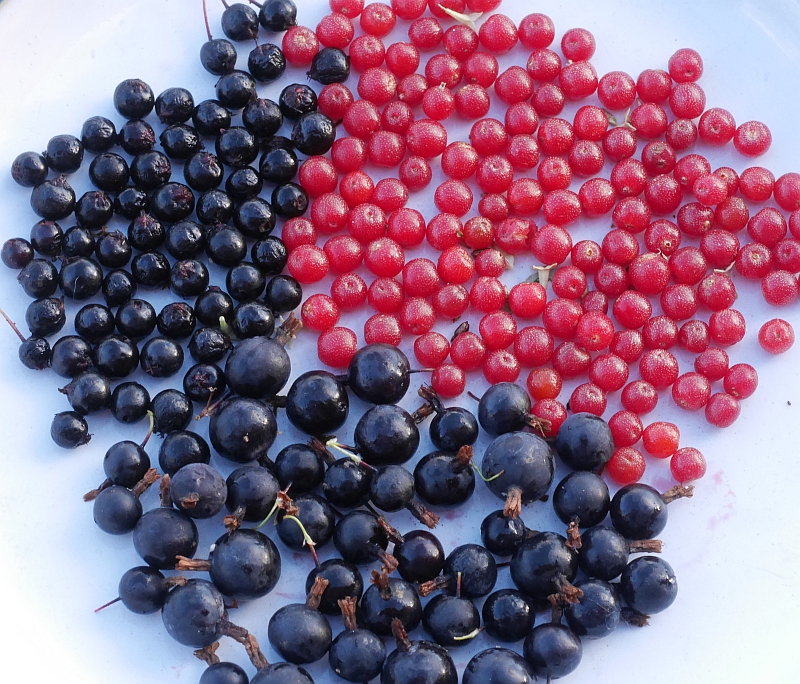
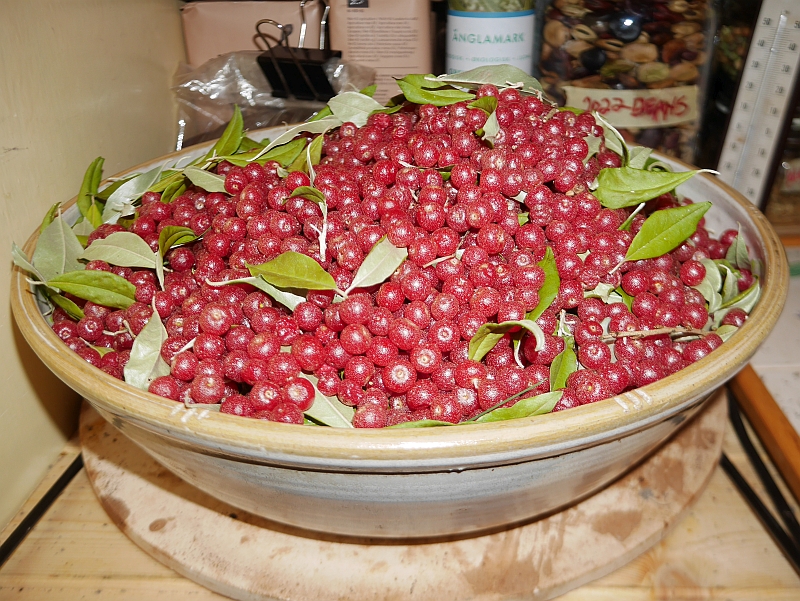 1st November 2023: The Autumn Olive is really producing well now! Still some to havest in the community garden!
1st November 2023: The Autumn Olive is really producing well now! Still some to havest in the community garden!
Apple Harvest
Due to the really cold May this year, the apple trees (Aroma) tried and tried to flower but seemed to give up. I was surprised nevertheless that some fruit did result and in compensation for the low number of apples, the individual apples were bigger so that the total yield was much better than feared! There were no plums and only a few cherries.
From one a day to over 20!
I only eat fruit that I grow or pick in the woods myself. For 5 months from November I only eat fresh stored apples from the cellar and they lasted right to the end of April this year. I don’t miss oranges, bananas or any of that commercial long distance fruit that I haven’t eaten regularly for over 25 years or more. Now until fresh fruit is once again available in July, I move suddenly from 1 species a day to over 20 a day, now using rehydrated dried fruit (including apples!), a mix of sweet, sour and bitter / strong tasting fruits (the same idea as the mixed salad!)
Includes: Apples (epler), sour cherries (surkirsebær), gooseberries (stikkelsbær), redcurrants (rips), blackcurrant (solbær), saskatoons (junisøtbær), Aronia, Berberis, Viburnum trilobum and Vibrnum opulus, bilberries (blåbær), bog bilberry (blokkebær), cloudberry (molte), plums (plommer), raspberries (bringebær), black raspberries (svartbringebær), Cornus mas, haskaps, Ribes odoratum, wild strawberries and a couple of wild Ribes spp. grwoing in the garden.
Join the SLOW FRUIT movement!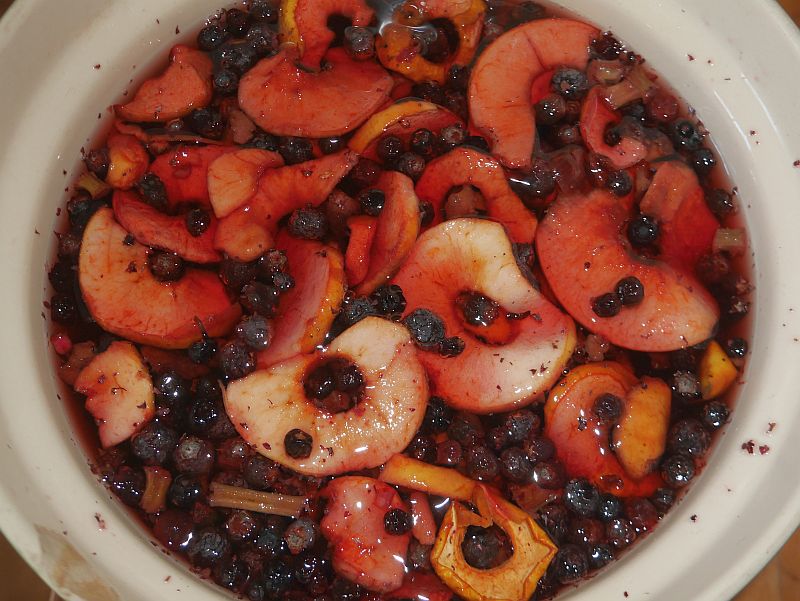
Nervous blackcap on apple
A male blackcap (munk) in the garden feeding nervously on an apple that a fieldfare (gråtrost) has been guarding attacking any bird that gets near.
…and then demonstrating that SIZE MATTERS as Herr Blackcap (munk) meets Hr. Hawfinch (kjernebiter) with guest appearances by Hr. Siskin (grønnsisik) and Hr. Brambling (bjørkefink)…..and there’s a finale!



